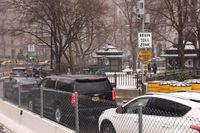On a sweltering August morning in Manhattan, a group of determined pedestrians set out to prove a point: sometimes, walking is faster than taking the bus. Their demonstration, which saw them outpace the city’s M-34 bus along the bustling 34th Street corridor, was more than just a quirky race—it was a bold call for change in how New York City manages its transit arteries. The walkers completed the journey from First Avenue to Eighth Avenue in just 15 minutes. The bus, meanwhile, lumbered along the same route, taking 22 minutes to reach the finish. As the crowd cheered, city leaders and transportation advocates seized the moment to highlight the urgent need for a dedicated, car-free busway on one of Manhattan’s busiest thoroughfares.
This demonstration came at a pivotal time for New York’s transit policy. Just days earlier, the City Council’s Committee on Land Use had approved a sweeping rezoning plan for Midtown South. Central to the plan: the creation of a car-free busway on 34th Street, alongside a proposal to add 9,500 new homes to the area. Council Member Erik Bottcher, a vocal supporter of the project, didn’t mince words about its importance. He stressed the need to remove “unnecessary private vehicles” from 34th Street, arguing that doing so would dramatically improve transit efficiency and help untangle one of the city’s most notorious traffic knots.
For many transit advocates, the recent pedestrian-bus race was a vivid illustration of a longstanding problem. Buses in Manhattan, often caught behind a wall of cars, taxis, and delivery trucks, have become synonymous with delays and frustration. But there’s a precedent for hope. According to the Department of Transportation commissioner, the 14th Street busway—implemented eight years ago—boosted bus speeds by 24%. “If it worked on 14th Street, why not 34th?” asked one activist during the demonstration, echoing the optimism of many supporters.
Of course, not everyone is convinced. Opponents of the proposed busway warn that removing cars from 34th Street could create headaches elsewhere, particularly on already congested arteries like Eighth Avenue. They point to existing backups as evidence that traffic doesn’t simply disappear—it moves. As one skeptic put it, “The cars have to go somewhere.” The debate is set to come to a head later this month, when the full City Council votes on the plan. Should it pass, Bottcher has pledged to push for swift implementation, hoping to ease commuting delays that have become all too familiar for the city’s workers and residents.
The conversation about busways and traffic in Manhattan is unfolding against a broader backdrop of global efforts to tackle urban congestion. Around the world, major cities have experimented with congestion pricing programs—market-based schemes that charge drivers a fee to enter the most crowded parts of town. The idea is simple: make it more expensive to drive where and when roads are busiest, and some people will opt for public transit, carpooling, or off-peak travel. The revenue generated, in turn, can be funneled into improving transit infrastructure or reducing other vehicle-related taxes.
Singapore was the pioneer, launching its congestion pricing program back in 1975. The results were immediate and striking: traffic dropped by 20% within just a few months. By 1998, Singapore had upgraded to a fully automatic system, with tolls that varied depending on location, time of day, vehicle type, and even real-time traffic speeds. According to Inrix, a traffic analytics firm, Singapore drivers lost just 20 hours to traffic delays in 2024—a fraction of the time lost by drivers in other global cities.
London followed suit in 2003, introducing a congestion charge that was initially met with skepticism. Before the tolls went into effect, 43% of Londoners surveyed opposed the plan. But within months, opposition fell below 31%, and a majority came to support the program. The impact was tangible: traffic in central London fell by 30%, and bus speeds in the zone increased by 6%. While London remains among the world’s most congested cities, the program has become a model for others.
Stockholm took a similar leap in 2006, initially facing resistance from residents. But after a year-long trial and a citywide referendum, the tolling program became permanent. Stockholm didn’t just charge drivers—it invested heavily in public transit, purchasing 197 new buses, adding 16 new bus lines, and expanding service across its network. The Swedish Transport Agency’s approach, with variable fees during peak hours, has helped keep the city moving.
Milan, too, has made strides. Starting with emissions-based charges in 2008 and switching to a congestion charge in 2012, the Italian city saw traffic in its Area C zone drop by 28% within two years. Collisions involving injuries declined by more than 26%, and carbon dioxide emissions plummeted by 35%. Milan now ranks 19th among European cities for average travel time over six miles, according to TomTom, a location technology company.
New York City, meanwhile, has recently joined the ranks of cities experimenting with congestion pricing. On January 5, 2025, it became the first U.S. city to implement such a program, charging vehicles to enter Manhattan at or below 60th Street. Six months in, the results have been promising. Fewer vehicles are entering the tolling zone, average bus speeds have increased year over year, and traffic delays have dropped by 10% in the Bronx and 14% in a dozen New Jersey municipalities. Transit ridership is up, and the toll revenues are being used to fund capital investments in public transit.
Not everyone is cheering, though. Opponents in the federal government have launched efforts to terminate New York’s congestion pricing program, raising questions about its future. Other U.S. cities—including Boston, Chicago, Los Angeles, and San Francisco—have studied congestion pricing but have yet to take the plunge. Still, some transportation experts see New York’s early success as a sign of things to come. “New York’s early success could set the stage for a nationwide shift in urban mobility,” said Ralf-Peter Schäfer, TomTom’s vice president of product management for traffic, in an opinion column published August 8, 2025. “City planners and policymakers across America stand to gain valuable insights from this real-world application of congestion pricing.”
As New York’s City Council prepares for its crucial vote on the 34th Street busway, the city finds itself at the crossroads of local action and global trends. The outcome could reshape not just one street, but the way America’s largest city—and perhaps others—think about the future of urban transportation.




